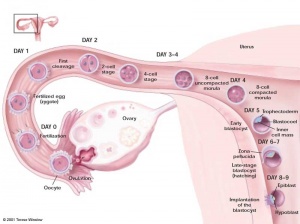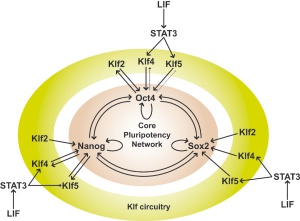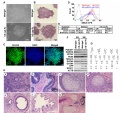Lecture - Stem Cells: Difference between revisions
No edit summary |
|||
| Line 99: | Line 99: | ||
</gallery> | </gallery> | ||
==References== | |||
<references/> | |||
{{2011ANAT2341}} | {{2011ANAT2341}} | ||
Revision as of 17:56, 10 October 2011
Introduction
Embryology is all about stem cells, a single cell (zygote) divides and differentiates to form all the tissues throughout the body. Furthermore within some tissues, stem cells remain to continuously replace cells that are lost through the life of that tissue. In recent years Scientific and general interest in this topic has increased due to the many issues that surround this specialised cell type. This lecture will introduce the various types/sources of stem cells as well as their practical and therapeutic potentials. A brief discussion of the pros and cons of different types of stem cells currently investigated in the field of medical research will be discussed.
Textbooks

|
Moore, K.L. & Persuad, T.V.N. (2008). The Developing Human: clinically oriented embryology (8th ed.). Philadelphia: Saunders.
|

|
Schoenwolf, G.C., Bleyl, S.B., Brauer, P.R. and Francis-West, P.H. (2009). Larsen’s Human Embryology (4th ed.). New York; Edinburgh: Churchill Livingstone.
|

|
Hill, M.A. (2011) UNSW Embryology (11th ed.). Sydney:UNSW.
|
Embryonic vs Adult Stem Cells
Embryonic Stem Cell Advantages
- Pluripotency - ability to differentiateinto any cell type.
- Immortal - one cell can supply endless amounts of cells.
- Easily available - human embryos from fertility clinics.
Embryonic Stem Cell Disadvantages
- Unstable - difficult to control differentiation into specific cell type.
- Immunogenic - potential immune rejection when transplanted into patients.
- Teratomas - tumor composed of tissues from 3 embryonic germ layers.
- Ethical Controversy - unethical for those who believes that life begins at conception.
Adult Stem Cell Advantages
- Already ‘specialised’ - induction of differentiation into specific cell types will be easier.
- Plasticity - Recent evidences suggest wider than previously thought ranges of tissue types can be derived.
- No Immune-rejection - if used in autologous transplantations.
- No Teratomas - unlike ES cells.
- No Ethical Controversy - sourced from adult tissues.
Adult Stem Cell Disadvantages
- Minimal quantity - number of isolatable cells may be small.
- Finite life-span - may have limited lifespan in culture.
- Ageing - stem cells from aged individuals may have higher chance of genetic damage due to ageing.
- Immunogenic - potential immune rejection if donor cells are derived from another individual.
Inducible Stem Cell

Yamanaka Factors
A set of 4 transcription factors when introduced into cells induces stem cell formation.[2] These four transcription factors can be expressed from doxycycline (dox)-inducible lentiviral vectors. The only culture difference in iPS cells and human embryonic stem cell culture is that iPS cell culture require 100ng/ml of bFGF in the culture media.
Outline of the MEF reprogramming protocol 1 Outline of the MEF reprogramming protocol 2 | stained with anti-Rex1, Sox2 and SSEA1 antibodies
- OCT4 Transcription factors containing the POU homeodomain
- MYC The MYC protooncogene encodes a DNA-binding factor that can activate and repress transcription. Ectopic expression of c-Myc can also cause tumorigenicity in offspring.
- SOX2 SRY-RELATED HMG-BOX GENE 2
- KLF4 Kruppel-like factor 4, zinc finger protein, transcription factor which acts as both an activator and repressor.
More recently shown that Oct4 together with either Klf4 or c-Myc is sufficient to generate iPS cells from neural stem cells.[3]
Thompson Factor
Images
- Stem cell therapy.jpg
Stem cell therapy
References
- ↑ <pubmed>20525219</pubmed>| BMC Dev Biol.
- ↑ <pubmed>16904174</pubmed>
- ↑ <pubmed>18594515</pubmed>
Co-ordinator Note
Dr Mark Hill |
ANAT2341 Embryology S2 2011
|
Course Content 2011
2011 Timetable: | Embryology Introduction | Fertilization | Cell Division/Fertilization | Week 1 and 2 Development | Week 3 Development | Week 1 to 3 | Mesoderm Development | Ectoderm, Early Neural, Neural Crest | Trilaminar Embryo to Early Embryo | Early Vascular Development | Placenta | Vascular and Placenta | Endoderm, Early Gastrointestinal | Respiratory Development | Endoderm and Respiratory | Head Development | Neural Crest Development | Head and Neural Crest | Musculoskeletal Development | Limb Development | Musculoskeletal | Renal Development | Genital | Kidney and Genital | Sensory | Stem Cells | Stem Cells | Endocrine Development | Endocrine | Heart | Integumentary Development | Heart and Integumentary | Fetal | Birth and Revision | Fetal
Glossary Links
- Glossary: A | B | C | D | E | F | G | H | I | J | K | L | M | N | O | P | Q | R | S | T | U | V | W | X | Y | Z | Numbers | Symbols | Term Link
Cite this page: Hill, M.A. (2024, May 5) Embryology Lecture - Stem Cells. Retrieved from https://embryology.med.unsw.edu.au/embryology/index.php/Lecture_-_Stem_Cells
- © Dr Mark Hill 2024, UNSW Embryology ISBN: 978 0 7334 2609 4 - UNSW CRICOS Provider Code No. 00098G











